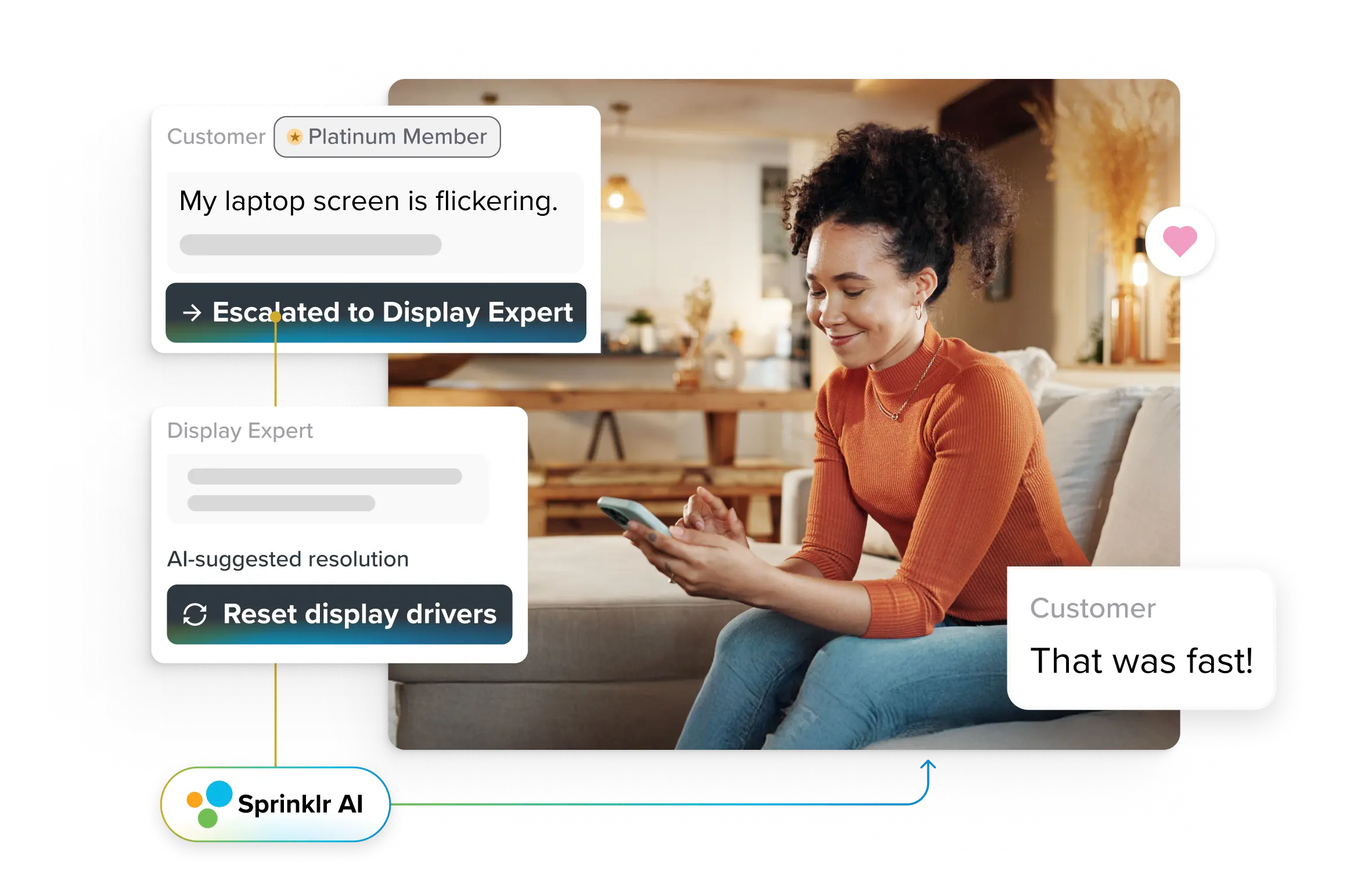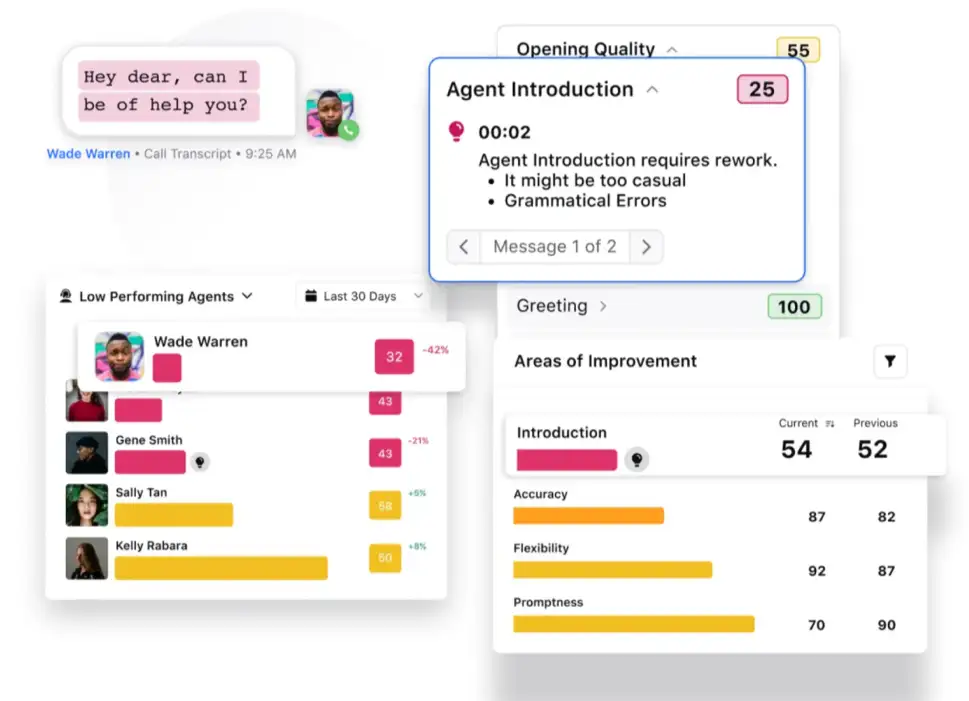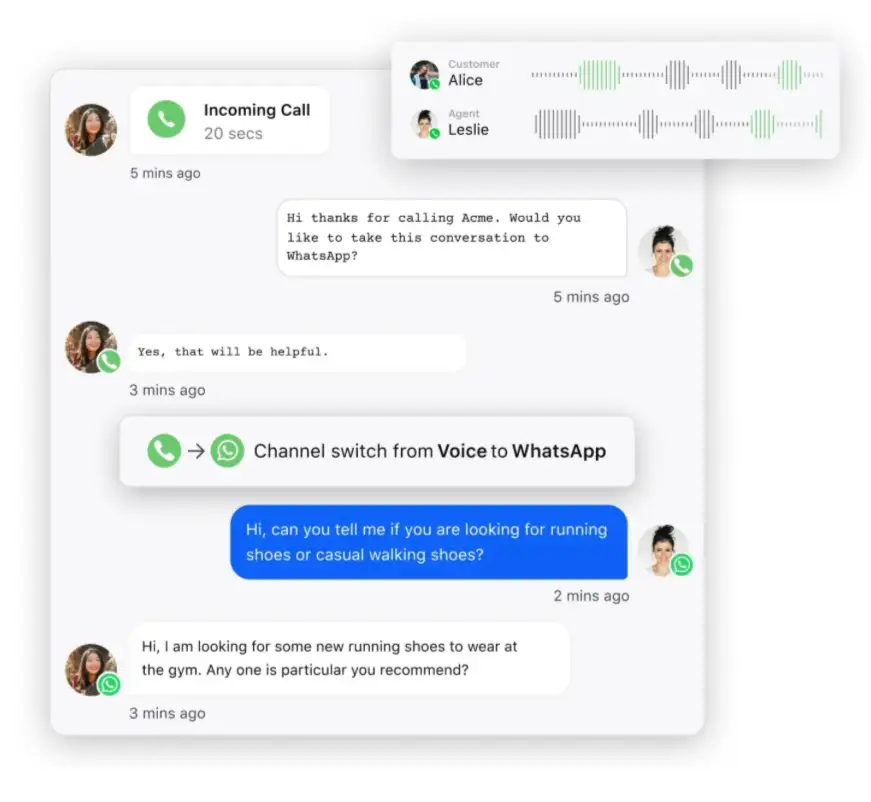Transform CX with AI at the core of every interaction
Unify fragmented interactions across 30+ voice, social and digital channels with an AI-native customer experience platform. Deliver consistent, extraordinary brand experiences at scale.

How AI is Redefining Customer Service Standards for 2025 and Beyond
In 2025, if a service disruption is looming, high-performing brands don’t wait for tickets to pile up; they reach out first. They send alerts. Offer solutions. And steer customers clear of friction before it snowballs into frustration.
This is the new customer service standard for customer-centric brands. And it’s being driven by a new generation of tech-savvy, hyper-connected consumers who expect personalized, seamless, and always-on service — across any channel, at any time.
According to customer service statistics, 80% of American consumers define great service as fast, convenient, and delivered by knowledgeable, friendly support.
But here’s the twist: they want that experience on their own terms.
Self-service has evolved from just a cost-efficiency tactic to a clear customer preference. In fact, 38% of Gen Z and Millennials will abandon a service issue entirely if they can’t resolve it themselves. That’s a wake-up call for contact centers still built around rigid, agent-first workflows.
So how do today’s enterprises keep pace with these evolving customer service standards—especially in complex, omnichannel, digital-first environments? Let’s unpack.
- What do customer service standards really mean?
- How enterprises scale service standards across teams and touchpoints
- The new benchmarks: 5 customer service standards in 2025
- 1. Proactive issue identification and resolution
- 2. Unified service across all digital touchpoints
- 3. Protect trust through context-aware compliance and secure support
- 4. Free up agents by automating repetitive backend tasks
- 5. Set consistent tone, empathy, and relational guardrails across all channels
- Role of AI in elevating customer service standards
- Set the bar. Then raise it with Sprinklr.
What do customer service standards really mean?
At its core, customer service standards define the level of service a business commits to delivering across every customer touchpoint. Think of them as a promise, written or implied, about how customers will be treated, how quickly issues will be resolved, and how consistent the experience will be, regardless of the channel or platform.
But here's where it gets real:
In 2025, customer service standards will no longer be determined solely by internal service level agreements (SLAs) or operational KPIs. They're being defined by customer expectations —expectations shaped by industry leaders, digital disruptors, and the best experience a customer had anywhere, even outside your industry.
To customers, service standards are the invisible rules that shape their experience:
- Will my issue be resolved without having to bounce between agents?
- Can I get help on a Sunday night without having to call?
- Is the chatbot smart enough to understand what I'm saying?
Customer-first brands understand that behind these questions lie human emotions — frustration, urgency, and hope — and they build their service design with empathy baked in. At an enterprise level, though, customer service standards typically operate on two interconnected planes:
- Strategic standards – These align with broader business outcomes, such as customer satisfaction, brand trust, customer loyalty, and lifetime value.
- Operational standards – These are the tactical benchmarks that bring strategy to life, including response time, first-contact resolution, NPS, and, increasingly, AI-enabled service efficiency.
📌 C-suite takeaway
Customers now expect proactive alerts, seamless handoffs, real-time updates, and personalized interactions, all without having to repeat themselves across channels. Anything less feels like friction.
For large-scale enterprises, this means rethinking what "standard" even looks like:
- Is it a 3-minute average handling time or a zero-effort resolution experience?
- Is it a well-staffed contact center or an AI-first ecosystem backed by agent expertise?
- Is it fast service or contextual service?
In essence, customer service standards are shifting from rigid metrics to flexible, experience-driven principles fueled by technology. This evolution is measured by how customers perceive their interactions and ultimately judged by the ease and comfort they feel throughout the process.
How enterprises scale service standards across teams and touchpoints
After analyzing over 6,000 customer journeys, Gartner found a common failure: a transition gap between customer self-service and human-assisted channels. These discrepancies frustrate customers, reduce the adoption of self-service, and negatively impact the overall customer experience (CX).
That’s why service standards must be baked into every business layer and codified, not just documented:
- Enterprises should build them into training programs, conversation workflows, and internal tools.
- They must create call center scripts that reflect tone guidelines. They should also regularly conduct customer service training using real call transcripts and agent scorecards.
- Consistency at scale also requires the right technology. Enterprise-grade customer service software enforces standards across channels and teams, from routing rules to tone consistency.
And it doesn't stop there. Innovative companies regularly audit service quality, track performance using scorecards, and gather feedback after interactions. These continuous loops help improve customer service while holding teams accountable, regardless of the operation's size.
The new benchmarks: 5 customer service standards in 2025
According to Gartner, the average self-service success rate across industries sits at a dismal 14%. It’s no surprise, then, that 90% of customer service and support leaders rank improving this as a top priority.
Why? Because the bar has been raised. In this section, we’ll explore the five defining customer service standards that leading enterprises are embedding into their CX strategies in 2025 and beyond.
1. Proactive issue identification and resolution
As mentioned initially, modern service is about identifying trouble before it occurs. Enterprises use early signals, such as product usage drops, support queries, or sentiment shifts, to trigger targeted outreach. AI helps detect friction quickly, enabling support teams to act before customers complain.
This shift builds trust. Customers feel valued rather than frustrated when issues get resolved before they escalate. It also reduces ticket volume, improves CSAT and maintains SLAs, all while protecting your brand reputation.
2. Unified service across all digital touchpoints
Customers don’t think in channels. They expect one seamless experience. Whether they contact you via WhatsApp, email, or live chat, they want consistent, contextual support that doesn't require them to repeat themselves.
Yet many enterprises still operate in silos — different tools, disconnected teams, and fractured handoffs. That’s a fast track to customer frustration and churn.
For modern enterprises, unified digital customer service must be the standard. Because that’s the only way agents gain full context, respond faster, and deliver personalized, human support — start to finish.
GO Telecom did exactly this by adopting Sprinklr Service. They brought all digital and social channels together, automated replies, offered omnichannel support, and used AI for smart triaging and sentiment analysis.
In just six months:
- CSAT rose by 20%
- Average handling time dropped 63%
- SLA adherence jumped from 11% to 75%
The impact of unified service was remarkable — smarter operations and stronger customer trust.
3. Protect trust through context-aware compliance and secure support
Speed alone doesn’t win loyalty; security and trust do. In industries such as finance, healthcare, and telecom, customers expect not only fast answers but also secure and compliant interactions every time. That’s why compliance can’t live in the back office. In 2025, it must be embedded directly into the service layer.
From the moment a ticket is created, AI should flag PII, detect regulatory red flags, and auto-route sensitive issues for secure handling. Chat transcripts need automatic redaction. Call recordings should be encrypted and audit-ready — by design, not as an afterthought.
Context-aware compliance tools ensure that your service is fast, frictionless, legally sound, and ethically aligned. In highly regulated environments, it’s a non-negotiable standard that protects both your customers and your brand reputation.
Get Your Hands On: Contact Center Compliance: Importance, Strategy & Checklist
4. Free up agents by automating repetitive backend tasks
Let's face it — most agents today spend more time summarizing calls, tagging tickets, and updating CRMs than actually helping customers. These tasks are necessary, but they're not where human value shines.
High-performing contact centers are changing that. AI now automates post-call summaries, case dispositioning, CRM updates, and ticket categorization — freeing agents to focus on what matters: empathy, resolution, and real-time problem-solving.
This is where Generative AI steps in. It handles the administrative load in the background while agents stay engaged in the conversation — no tab-hopping, no note-juggling. As a result, you unlock faster resolutions, more meaningful customer interactions, and a drastic reduction in agent burnout (a challenge flagged by 88% of customer service professionals).

5. Set consistent tone, empathy, and relational guardrails across all channels
Customers may forget what your agent has said. But they won't forget how they felt. That's why customer service tone, empathy, and consistency matter more than script or SLA.
Leading enterprises train agents not just on systems but also on emotional intelligence. That includes using the customer's name, showing ownership with phrases like "Let me fix this for you," and avoiding language that shifts blame. These shape how your brand is remembered after resolving the issue.
This consistency needs reinforcement through quality coaching, feedback loops, and AI-powered call audits that flag tone deviations or missed empathy cues. Whether a live agent or an AI assistant, your brand's voice should feel steady, human, helpful, and worth returning to.
💡 Do you know
With Sprinklr’s quality management software, you can automatically evaluate 100% of interactions across voice and digital channels. Score conversations against 30+ quality and compliance parameters — including empathy, active listening, and tone — powered by AI that also explains the “why” behind every score. See how modern enterprises coach at scale without sacrificing the human touch. 👇

Role of AI in elevating customer service standards
As customer expectations grow in both speed and complexity, traditional service models are hitting their limits. That’s why the role of AI in customer service isn’t just expanding — it’s becoming foundational. Here’s how AI is set to redefine customer service standards in the years ahead.
- Route smarter, not harder with AI-led prioritization
AI-powered routing is no longer just about categorizing tickets; it's about optimizing the entire workflow. Today, it's about understanding context and making informed decisions in real time. By analyzing urgency, customer sentiment, historical behavior, and even intent signals, AI can route each query to the most appropriate resource — whether that's a specialized agent, a retention expert, or an automated self-service path.
Take, for example, a complaint from a high-value customer. It won't be treated the same as a general inquiry. AI identifies risk patterns, flags potential churn, and fast-tracks critical issues to the right hands. Simultaneously, it deflects low-effort, repetitive queries to automation — freeing up agent bandwidth and helping teams stay ahead of SLA targets.
This kind of smart, intent-based routing — powered by machine learning — gets sharper with every interaction. Over time, your system evolves to become faster, more accurate, and increasingly aligned with your business priorities.
📚 Read More: What is omnichannel routing? A detailed guide.
- Deflect routine tickets with intelligent self-service
Not every query requires an agent. AI-powered chatbots, virtual agents, and knowledge bases can resolve routine issues, such as order tracking, password resets, and how-to guidance, quickly and efficiently. But for self-service to truly work, it must be done right.
That means using platforms built on advanced natural language processing (NLP), so bots understand real customer questions — not just keywords. Your knowledge base must also be continuously updated with real-time customer insights and usage patterns. Smart fallback logic is critical: when a bot reaches its limit, it should seamlessly hand off to a live agent, retaining full context.
Remember that when executed well, customer self-service builds autonomy, speeds up resolution, and leaves customers feeling empowered and not frustrated.
🎯Pro Tip
Long hold times are no longer acceptable to today’s customers, and they can quickly erode satisfaction. To address this, customer-first brands are adopting AI-powered conversational IVR systems that proactively deflect calls once wait times cross a certain threshold.
Sprinklr’s Conversational IVR takes this a step further. It not only redirects customers to self-service channels like WhatsApp with a seamless handoff but also offers a thoughtful apology and the option to receive a callback at the earliest available opportunity.

- AI agent assistance helps resolve issues faster
Even the most experienced agents encounter friction, whether it’s digging through case histories, switching between tools, or figuring out how to phrase the next response. AI-powered agent assist software eliminates friction and unlocks faster, smarter support.
During live interactions, it delivers real-time guidance by surfacing relevant knowledge articles, previous case context, and response suggestions, all within the same interface — no more tab-switching or second-guessing.

Set the bar. Then raise it with Sprinklr.
Enterprise customer service is no longer judged in isolation. It's measured against the best experience your customer had anywhere. And in 2025, that bar is higher than ever. Customers expect immediate resolution, consistent tone, personalized context, and, above all, effortless experiences across every channel.
But here's the hard truth: siloed systems, legacy processes, and human bandwidth limitations make it almost impossible to meet those expectations at scale. That's the real pain point.
It's not a lack of people or intent; it's the lack of a unified foundation that brings your teams, tools, data, and service standards together. Without it, even your best agents are fighting uphill battles.
Sprinklr Service helps you change that.
With AI at its core and unification as its principle, Sprinklr empowers you to deliver proactive, intelligent, and consistent service across every touchpoint without compromising security, empathy, or speed. From agent assist to AI-powered quality management, smart routing, and self-service deflection, it's built for CX leaders who are ready to elevate their support strategy from reactive to remarkable. Ready to set new service benchmarks in 2025?
Book a Sprinklr Service demo today and see how leading enterprises are transforming customer service into a competitive advantage.












